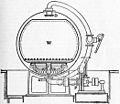Kier (industrial)

A kier or keeve (or similar spellings) is a large circular boiler or vat used in bleaching or scouring cotton fabric. They were also used for processing paper pulp.
In use they were continuously rotated by an engine, steam being supplied through a rotating joint in the axle. They were usually spherical, sometimes cylindrical, and some were recycled from old boiler shells.[1]
Kier boiling[]
Kier, the cylindrical-shaped vessel, straight, with egg-shaped ends made of boiler may have the capacity to process one to three tons of material at a time.[2]
Kier boiling and ''Boiling off'' is the scouring process that involves boiling the materials with the caustic solution in the Kier, which is an enclosed vessel, so that the fabric can boil under pressure.[3][4][5] Open kiers were also used with temperatures below 100°C (at atmospheric pressure).[6]: 102
Gallery[]

Spherical kier

Straw boiler at the historical precinct at Broadford, Victoria

The Mather Kier, cross section

The Mather Kier, longitudinal section
See also[]
- Textile finishing
- Textile bleaching
References[]
| Wikimedia Commons has media related to Kiers. |
- ^ McEwen, Alan (2009). Historic Steam Boiler Explosions. Sledgehammer Engineering Press. ISBN 978-0-9532725-2-5.
- ^ Knecht, Edmund (1911). . In Chisholm, Hugh (ed.). Encyclopædia Britannica. 04 (11th ed.). Cambridge University Press. pp. 49–55, see page 50, fifth para.
Bleaching of Cotton....The first operation, viz. that of boiling in alkali, is carried out in a “kier,” a large, egg-ended, upright cylindrical vessel, constructed of boiler-plate and capable of treating from one to three tons of yarn at a time
- ^ Purushothama, B. (2019-01-31). Handbook of Value Addition Processes for Fabrics. Woodhead Publishing India PVT. Limited. p. 27. ISBN 978-93-85059-92-6.
- ^ Marsh, John Thompson; Wood, Frederick Charles (1945). An Introduction to the Chemistry of Cellulose. Chapman & Hall. p. 26.
- ^ Lacasse, K.; Baumann, Werner (2012-12-06). Textile Chemicals: Environmental Data and Facts. Springer Science & Business Media. p. 95. ISBN 978-3-642-18898-5.
- ^ Trotman, E. R. (Edward Russell) (1968). Textile scouring and bleaching. Internet Archive. London, Griffin. ISBN 978-0-85264-067-8.
- Textile machinery
- Cotton production
- Bleaches
- Boilers
- Textile stubs
- Industry stubs




